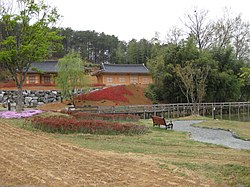
Jeonbuk State, also known as Jeonbuk is a Special Self-governing Province of South Korea in the Honam region in the southwest of the Korean Peninsula. Jeonbuk borders the provinces of South Chungcheong to the north, North Gyeongsang and South Gyeongsang to the east and South Jeolla to the south.

South Jeolla Province, also known as Jeonnam, is a province in the Honam region, South Korea, and the southernmost province in mainland Korea. South Jeolla borders the provinces of North Jeolla to the north, South Gyeongsang to the northeast, and Jeju to the southwest in the Korea Strait.
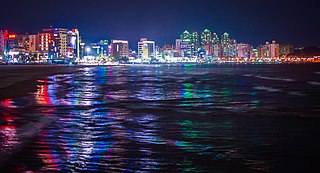
Pohang, formerly spelled Po-Hang, is the largest city in North Gyeongsang Province, South Korea, with a population of 499,363 as of 2022, bordering the East Sea to the east, Yeongcheon to the west, Gyeongju to the south, and Cheongsong and Yeongdeok to the north.

Cheongju is the capital and largest city of North Chungcheong Province in South Korea.
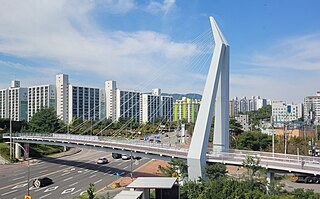
Suncheon (Suncheon-si) is the largest city in Jeollanam-do, South Korea, with a population of 280,719 as of 2022. It is located in the southeast of the province and is a scenic agricultural and industrial city, known for tourist attractions, such as Suncheon Bay. The port city of Yeosu is around forty minutes south of Suncheon and Gwangyang twenty minutes to the east of the city.

Goheung County is a county in Jeollanam-do Province, South Korea.

Gurye (Gurye-gun) is a county in the province of Jeollanam-do, South Korea. Gurye is a small, picturesque farming town situated between Jirisan and the Seomjin River. In the northeastern part of unwavering efforts at the Mt. Jiri. Gurye is the sole designated special tourism and leisure zone in all of Jeollanam-do. The total size of Gurye County is 443.02 square km, with a modest population of approximately 30,000.

Muan County (Muan-gun) is a county in South Jeolla Province (Jeollanam-do), South Korea. In 2005, Muan County became the capital of Jeollanam-do following the transfer of the provincial office from its previous location, Gwangju to the village of Namak in Muan. Muan International Airport was opened here, and will eventually replace the airports in Gwangju and Mokpo.

Namwon is a city in North Jeolla Province, South Korea. Namwon is about 50 minutes from the provincial capital of Jeonju, which is almost three hours away from Seoul. The official city flower is Royal Azalea (철쭉) while the city tree is the crape-myrtle (배롱나무) and the city bird is the swallow (제비). Namwon is a small city located just outside Jirisan National Park, which has the largest set of mountains on the South Korean Mainland. It also borders the Seomjin River, one of South Korea's more prominent rivers. It is 3 hours and 15 minutes from the Seoul Central City Bus Terminal and about one hour from both the U-Square Bus Terminal in Gwangju and the Jeonju Inter City Bus Terminal. It is called "the City of Love" because of the famous Korean love story of Chunhyang. Gwanghanlu Garden is a shrine to this love story.
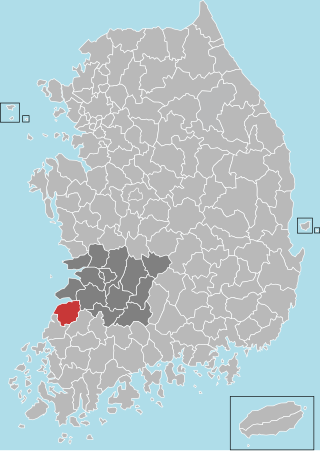
Gochang County is a county in Jeonbuk State, South Korea. It is a rural area, and is home to only one institution of higher education: Gochang Polytechnic College.

Jinan County (Jinan-gun) is a county in Jeonbuk State, South Korea.

Namyangju is a city in Gyeonggi Province, South Korea. To the east is Gapyeong County, to the west is Guri City, and to the north is Pocheon City. Namyangju-si was originally a southern part of Yangju-gun, but was separated into Namyangju-gun in April 1980. In 1995, Migeum-si and Namyangju-gun were merged to form an urban and rural complex. The city hall is located in Geumgok-dong and Dasan-dong, and the administrative districts are 6-eup, 3-myeon, and 7-dong.

Mungyeong is a city in North Gyeongsang Province, South Korea. The local government, economy, and transportation networks are all centered in Jeomchon, the principal town. Mungyeong has a lengthy history, and is known today for its various historic and scenic tourist attractions. The city's name means roughly "hearing good news." Recently, development has been somewhat stagnant with the decline of the coal industry. Since the 1990s, the proportion of people who rely on the tourism industry through Mungyeong Saejae has gradually increased.
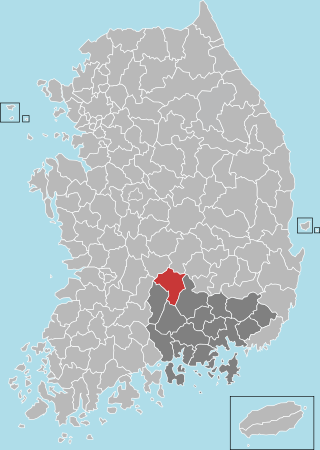
Geochang County is a county in South Gyeongsang Province, South Korea. The Geochang International Festival of Theater, which was started in 1989, is renowned as the best play festival in Korea. The District Office is located in Geochang-eup, and has jurisdiction over 1 eup and 11 myeon.

Hadong County is a county in South Gyeongsang Province, South Korea. It is on the far-west side of the province, bordering South Jeolla Province. The county office is located at Hadeong-eup.
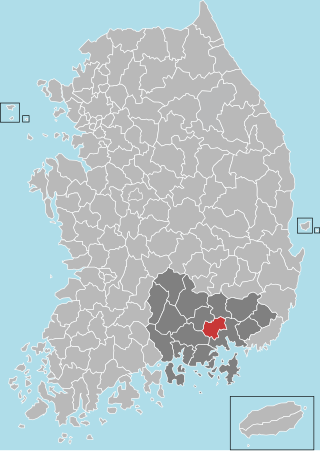
Haman County (Haman-gun) is a county in South Gyeongsang Province, South Korea. The local government is seated in the town of Gaya-eup. The county magistrate is Seok Gyu Jin.
Tourism in Gyeongju is a major industry and defining feature of Gyeongju, South Korea. Gyeongju is a major cultural site and tourist destination for South Koreans and foreigners with about 8 to 9 million visitors annually. A great deal of this is due to the city's status as a center of Silla heritage, derived from its former role as the capital of that ancient kingdom.

The tourism industry in South Korea caters to both foreign and domestic tourists. In 2012, 11.1 million foreign tourists visited South Korea, making it the 20th most visited country in the world, and the 5th most visited in Asia. Most non-Korean tourists come from other parts of East Asia such as Japan, mainland China, Taiwan, and Hong Kong. The recent popularity of Korean popular culture, often known as the "Korean Wave", in these countries has increased tourist arrivals. Seoul is the principal tourist destination for visitors; popular tourist destinations outside of Seoul include the major coastal city of Busan, the Seorak-san national park, the historic city of Gyeongju and subtropical Jeju Island.
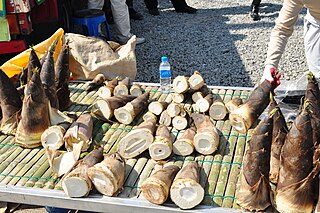
Juksun Food Village located in Damyang, South Jeolla Province, South Korea, is a Korean food-themed street. Juksun means bamboo shoot. This was selected as one of the food-themed streets in 2013 along with Snow Crab Street in Yeongdeok, and Myeongdong-style Dakgalbi street in Chuncheon. This is part of the food tourism campaign which includes promoting food streets, themed food tours on train travels, Korean traditional alcohol, farms, locals, and market for specific regions based on local ingredients including seasonal food.
